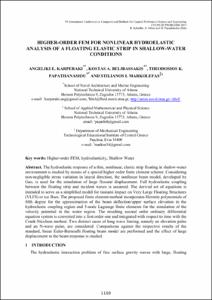Higher-order fem for nonlinear hydroelastic analysis of a floating elastic strip in shallow-water conditions

Visualitza/Obre
Estadístiques de LA Referencia / Recolecta
Inclou dades d'ús des de 2022
Cita com:
hdl:2117/191991
Tipus de documentText en actes de congrés
Data publicació2015
EditorCIMNE
Condicions d'accésAccés obert
Tots els drets reservats. Aquesta obra està protegida pels drets de propietat intel·lectual i
industrial corresponents. Sense perjudici de les exempcions legals existents, queda prohibida la seva
reproducció, distribució, comunicació pública o transformació sense l'autorització del titular dels drets
Abstract
The hydroelastic response of a thin, nonlinear, elastic strip floating in shalow-water
environment is studied by means of a special higher order finite element scheme. Considering
non-negligible stress variation in lateral direction, the nonlinear beam model, developed by
Gao, is used for the simulation of large flexural displacement. Full hydroelastic coupling
between the floating strip and incident waves is assumed. The derived set of equations is
intended to serve as a simplified model for tsunami impact on Very Large Floating Structures
(VLFS) or ice floes. The proposed finite element method incorporates Hermite polynomials of
fifth degree for the approximation of the beam deflection/upper surface elevation in the
hydroelastic coupling region and 5-node Lagrange finite elements for the simulation of the
velocity potential in the water region. The resulting second order ordinary differential
equation system is converted into a first order one and integrated with respect to time with the
Crank-Nicolson method. Two distinct cases of long wave forcing, namely an elevation pulse
and an N-wave pulse, are considered. Comparisons against the respective results of the
standard, linear Euler-Bernoulli floating beam model are performed and the effect of large
displacement in the beam response is studied.
ISBN978-84-943928-3-2
| Fitxers | Descripció | Mida | Format | Visualitza |
|---|---|---|---|---|
| Coupled-2015_10 ... rder FEM for nonlinear.pdf | 524,1Kb | Visualitza/Obre |

